|
|
 |
| Welcome | Getting Started | Resources | Site Map |
Week 4
Roughages |
Instructions for listening to audio clips
- Download the QuickTime Player to listen to the audio files.
- Read the QuickTime Instructions for installation help.
- Download the RealPlayer to listen to the audio files
- Instructions are on the RealPlayer download page
High moisture forages Silage
Follow along with the audio...
- High-moisture forage
- 60% to greater than 70% moisture
- Controlled fermentation of high-moisture forages
- Harvested at stages of forage growth and fed as necessary
- Given appropriate management
- Palatable
- High nutritional value
- Primarily fed to beef and dairy cattle
- Figures 9.11 and 9.12 Consuming rations containing silage
- Fed to sheep and horses
- Favorable production results
- Maximize DMI, ensile at minimum moisture required for ensiling
- Ensiled
- Grass and legume forages
- Corn and sorghum grain crops
- Various crop surpluses and residues
- Effective method to maximize yield of digestible nutrients per unit of land
- Ensiling
- Process
- High-moisture forages harvested
- Loaded into structure
- Anaerobic fermentation preserves nutrients
- Factors
- Physical and chemical properties of forage
- Establishment and maintenance of anaerobic environment
- Composition and activity of population of microorganisms
- Approximately 2-3 weeks
- Phase one
- Aerobic
- Immediately after harvest
- Plant enzymes and aerobic microorganisms
- Convert organic materials to carbon dioxide, water, and heat
- Nonstructural CHO and proteins
- Extended duration
- Excessive nutrient loss and heating
- Completed with establishment of anaerobic conditions
- Less than six hours
- Phase two
- Initial anaerobic fermentation
- Acetic acid producing microorganisms
- Nonstructural CHO to acetic acid
- Acetic acid
- Energy source
- Reduce pH to app. 5.0
- One to three days
- Phase three
- Lactic acid producing microorganisms
- Nonstructural CHO to lactic acid
- Lactic acid
- Most desirable acid
- Strong acid
- Energy source
- Palatable
- Completed when pH is 4.0-4.5
- Inhibiting microbial growth
- Preserving nutrients in forage
- Indicators
- pH
- Grass: 4.5
- Corn silage: 4.0
- Composition of acids
- Lactic acid predominate
- 4-8% of DM
- Phase four
- Feed-out
- Period in which unloaded from structure and fed
- Exposed to oxygen
- Oxygen initiates secondary aerobic degradation and yeast and fungi growth
- Minimize duration of time from exposure to oxygen to animal consumption
- Harvesting
- Figure 9.13 Corn silage being cut, chopped, and transferred to forage wagon in field
- Stage of maturity
- To maximize yield of digestible nutrients per unit of land
- Table 7-20 on page 147 of text Harvest maturity for various forages
- Moisture content
- Efficiency of microbial fermentation, establishment of anaerobic conditions, and minimizes seepage
- Varies by silo and forage
- Table 7-21 on page 148 Methods to estimate moisture content of forage
- Table 7-20 on page 147 Acceptable range of moisture at ensiling for various forages
- Figure 9.14 Associated losses at various moisture levels with various ensiling structures
- Classifications
- Direct-cut; 70% or greater moisture
- Corn and other grain crops
- Wilted; 60-70% moisture
- Grasses and legumes
- Figure 9.15 Wilted forage collected, chopped, and transferred to wagon in field
- Low-moisture; 40-60% moisture
- Grasses and legumes
- Nonstructural CHO content
- Efficiency of ensiling process
- Primary substrate for acid production
- Optimal maturity promotes adequate levels
- Chopping
- Promotes establishment of anaerobic conditions
- In general, optimal is 1/4 to 1/2
- Type of forage, ensiling structure, and rate of inclusion in ration
- Table 7-20 on page 147 Recommended length of cut or chop for various forages
- Loading and packing
- Loading
- Establish and maintain anaerobic conditions
- Unloading
- Rapidly, continuously, consistently
- Packing
- Establish and maintain anaerobic conditions
- Consistently and sealed rapidly
- Method dependent on ensiling structure
- Ensiling structure
- Vertical, conventional silos (tower silos)
- Figure 9.16 - Vertical, conventional silo (right)
- Vertical, oxygen-limiting silos
- Figure 9.16 Vertical, oxygen-limiting silo (left)
- Oxygen-limiting store high-moisture grains and low-moisture forages
- Horizontal, bunker silos
- Figure 9.17 Horizontal, bunker silo
- Bag silos
- Figure 9.18 - Silage being bagged
- Requirements
- Establishment and maintenance of anaerobic environment
- Efficient loading, packing, and unloading
- Sizing
- Factors
- Loading, packing, and unloading of silage
- Quantity of forage fed per day
- Duration of time forage fed
- Vertical
- Minimize feed losses
- Loading and unloading efficient
- High investment in facility and equipment
- Horizontal
- Low capital investment in facilities and equipment
- Loading and unloading labor-intensive
- Potential for high feed losses
- Bags
- Low capital investment
- Minimal feed losses
- Loading and unloading labor-intensive
- Losses
- Minimize to maximize yield of digestible nutrients
- Average losses are 15-25% of DM
- Associated with harvesting and handling minimal
- Primary losses associated with fermentation, storage, and feed-out
- Table 7-22 on page 149 Summary of harvesting methods for alfalfa with associated losses
- Additives
- Improve the ensiling process and nutritional value of ensiled forage
- Not required
- Not substitute for management
- Classified
- Nutrients
- NPN and other protein sources
- Feeds low in CP and high in energy
- Increase CP
- Fermentable CHO sources
- Grains and molasses
- Feeds low in energy and high in CP
- Efficiency of ensiling process
- Chemical preservatives
- Organic acids
- Reduce degradation of CP and CHO
- Especially, direct-cut
- Inhibit select microorganism
- Biological agents
- Lactic acid producing microorganisms
- Establishment of and fermentation by lactic acid producers
- Microbial enzymes
- Increase quantity of nutrients available for fermentation
- Evaluation of nutritional value
- Sensory
- Visual, tactile, and olfactory senses
- Bright, crisp color, firm texture, clean acidic odor, and absent from antinutritional factors and contaminants
- Analytical
- Standard forage analyses
- pH
- Composition of acids
- Nitrogen component
- Corn silage
- In U.S., most popular ensiled forage
- Figure 9.19 Field of corn silage
- Figure 9.20 Corn silage being harvested
- Favorable characteristics associated with crop production, nutritional value, and feeding value
- Crop production
- High yield of digestible nutrients per unit of land
- Nutritional value
- Structural CHO and nonstructural CHO (e.g. energy)
- High to moderate in DE
- TDN
- 65-75% of DM
- Low to moderate in CP
- 8-9%
- Average NDF
- 51%
- Average ADF
- 28%
- Feeding value
- Palatable
- Supplement with protein, mineral, vitamin, and potentially, energy to maximize nutritional value
- Factors
- Hybrid selection
- Fertilization
- Maturity at harvest
- Yield and digestibility of nutrients and ensiling characteristics
- Identified by location of milk line
- Milk line
- Line in kernel separating liquid and solid portions of kernel
- Figure 9.21 Various milk lines
- Figure 7.16 on page 155 of text Kernel milk line (e.g. maturity) and expected DM yields
- As plant matures, outside to inside
- Table 7-33 Plant composition and energy yields of whole plant corn harvested at three different maturities
- Optimal stage to maximize energy value of silage, moisture content for ensiling, and maximize animal consumption is one-half to two-thirds down kernel
- Moisture level 65-70%
- Harvest, storage, and feeding management
- Chop size
- Table 7-20 on page 147 Optimal chop size for corn silage
- Processing
- Improve nutritional value
- Disrupt physical structures and reduce physical size of particles of plant
- Additional ensiled forages
- Sorghum, grasses, legumes, small grains, and crop residues and surpluses
- Nutritional value and various silage production specifics will differ, basic principles of silage production also apply
- Ensiling also means to manage specific forage issues
- Ensiling will reduce nitrate, prussic acid, and various other
compounds, and reduce opportunity for bloat
- Ensiling will reduce nitrate, prussic acid, and various other
compounds, and reduce opportunity for bloat
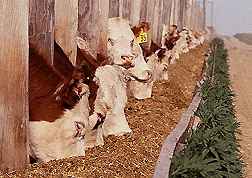
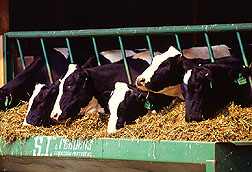
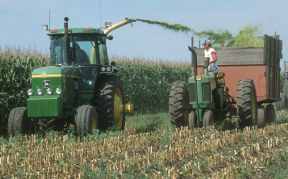
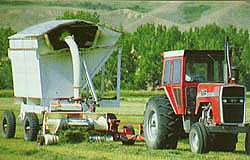
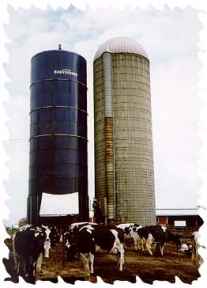

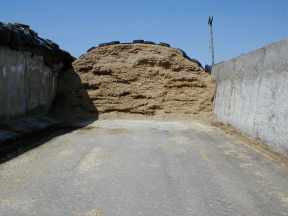

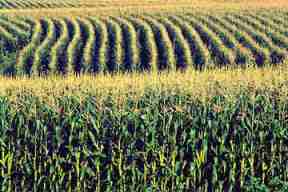
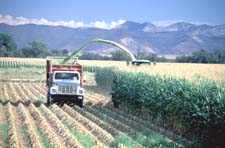
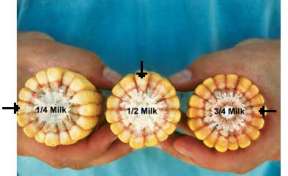
| |
| Welcome | Getting Started | Resources | SiteMap |
